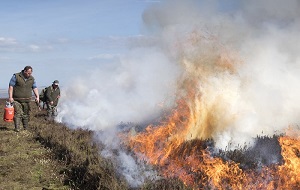Legislation to Ban the Burning of Heather
New regulations ban heather burning (and specified vegetation) on areas of peatland in England (deeper than 40 centimetres) on:
- A Site of Special Scientific Interest (SSSI) if it also qualifies as a (either):
- Special Area of Conservation
- Special Protection Area (e.g. land designated under Directive 2009/147/EC on the Conservation of Wild Birds)
Note: Some exceptions apply to the new legislation (e.g. after being granted a licence or on land that is rocky or steep).
The controlled use of ‘rotational’ burning takes place during the winter months. Many land owners use the eight to twelve year rotation technique to clear broad patches of older heather.
Nonetheless, a consensus shows that the burning of most vegetation on blanket bog habitats actually damages peatland formation.
As a direct result, this kind of land management tool often creates several serious consequences and unnatural side effects, including:
- Making habitat restoration extremely difficult (and sometimes impossible).
- Interfering with hydrology restoration (e.g. the distribution, management, and movement of natural water courses).
The Importance of England’s Peatlands
The government has made the restoration of peat land, often referred to as the ‘national rainforests’ of England, a major priority.
Projects such as these have become even more important, since:
- They will help the United Kingdom to achieve net zero carbon emissions by the year 2050.
- Peatlands create a range of diverse habitats for much of the wildlife and biodiversity that they support.
- Blanket bogs are delicate habitats of international importance. In fact, the United Kingdom contains around 13% of all blanket bog on the planet.
Note: The main section explains much more about the key rules of the countryside and rural landscapes in the United Kingdom.
Developing Wildfire Control Plans
So, what are some of the serious outcomes of unmanaged moorland? The most damaging is the risk of wildfire – seen as an increasing one due to the effects of climate change.
For this reason, the government is working with land managers and owners to develop further controls to reduce the risk of local wildfires.
Certain circumstances are exempt from the ban on burning heather (e.g. where scree makes up at least half of the total land mass).
Other reasons for the Secretary of State to issue a licence that is aligned with coherent management plans, include:
- Burning heather on blanket bog for wildfire prevention.
- Conservation purposes.
- Land inaccessible to cutting or mowing machinery.
The Environment Secretary reiterated how peatlands have a tremendous potential to be natural stores of carbon. Furthermore, they help to protect animal habitats by providing havens for rare wildlife.
Defra and Natural England Announcement
Natural England sees the new heather burning legislation as a welcome announcement. Thus, the emphasis goes to protecting important peatlands around the country.
The essential environment that blanket bog provides should not be understated. Besides carbon storage, creating homes for diverse wildlife, it also forms structures for flood mitigation and clean drinking water.
For these reasons, ensuring these systems are healthy with peat-forming species, such as Sphagnum peat moss (one of 380 mosses that thrive in water-logged conditions) is vital.
25 Year Plan to Improve the Environment
New legislation to ban burning heather on rotation in England is only one part of the nature and climate change adaptation targets. Yet, it forms an essential contributor to the 25 Year Environment Plan – a firm commitment for bringing 75% of all SSSIs into favourable conditions.
Note: The statutory instrument for preventing the burning of heather and other vegetation on protected blanket bogs comes into force after being laid before Parliament for its approval.
Related Rule Guides
- Rights of Way Rules (accessing public and private land).
- How to appeal a hedgerow notice?
- UK rules for protecting rural landscapes and features.
Note: The video, presented by Channel 4 News, explains some of the controversies around muirburn and controlling the heather with burning across the United Kingdom.

